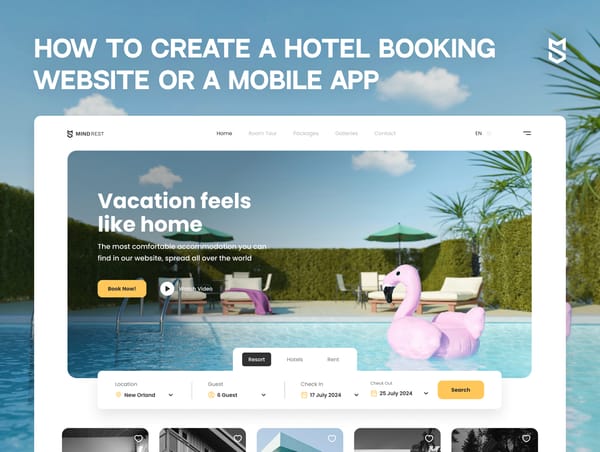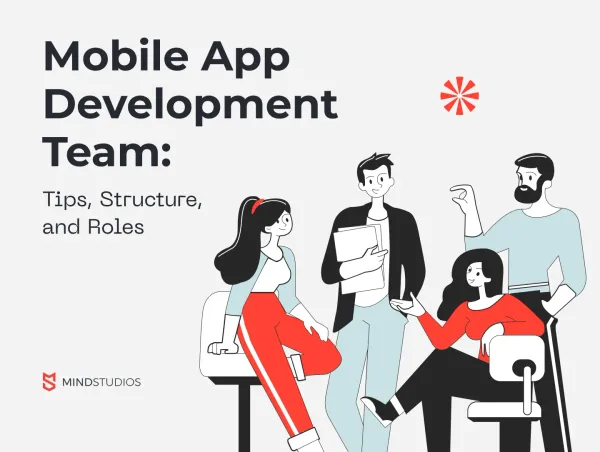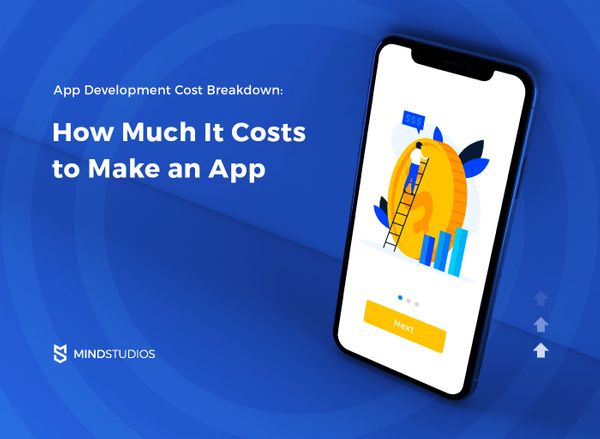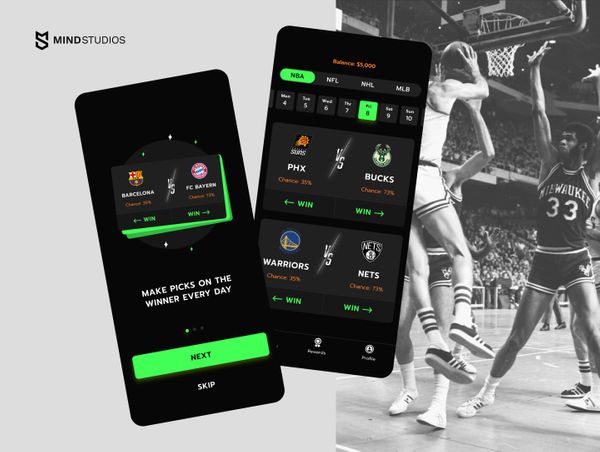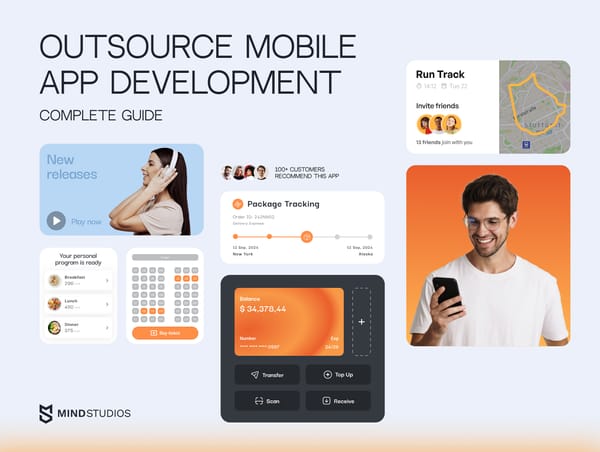With the continuous rise of the number of apps an average user interacts with, there is also a rise in the number of people who are interested in the unlimited possibilities an app development world can offer. Now, you need a good idea, an expert development team, and enough time and money to create your own solution.
And the first question that comes to mind in such scenarios is “How much does it cost to make an app?”. As we’ve already covered this topic in one of our previous articles, so now let’s look at the second question — “How long does it take to make an app?”.
Both of those questions are way more complex than they seem and the answers depend on many affecting factors. Although these answers will vary based on the app details, we can still develop a generalized answer. To do so, in this article, we are going to
- overview of the process of app development,
- take a closer look at its every stage,
- provide average time frames from our experience,
- point out the factors that influence app development speed,
- share our experience in building apps within the strictest time limits we’ve ever had.
Let’s unveil the concept of time in the mysterious app development process.
App development process overview
There's a popular misconception that all an app needs to be successful is quality code and an eye-catching user interface. This misconception was debunked multiple times, yet it persists. In reality, there's more to popular apps than meets the eye, and it's crucial to have a good understanding it’s crucial to have a good understanding of the process from the inside.
Generally, the app development timeline looks like this:
- Discovery stage
- Idea validation
- Design strategies and pre-development
- Development and design
- Testing and bug-fixing
- Launch
So, it takes 3 separate stages to proceed to the “coding” part and to increase your chances for a successful development, we don’t recommend skipping any of them. The thorough planning stages are essential to validate your initial idea, test its viability, define the development strategies, and recognize potential pitfalls beforehand. There, you also obtain an understanding of what you want to build, what you can build, and how to build it efficiently.
Typical time frames for app development stages
Building a software solution is a process that can’t be accurately predicted, and its timeline will vary from case to case, making it hard to be absolute in any estimations. However, we can still define the average time to make an app by looking at the app development step-by-step. In this section, let’s build a bigger picture of the time it takes to develop an app, starting from the smaller processes it consists of.
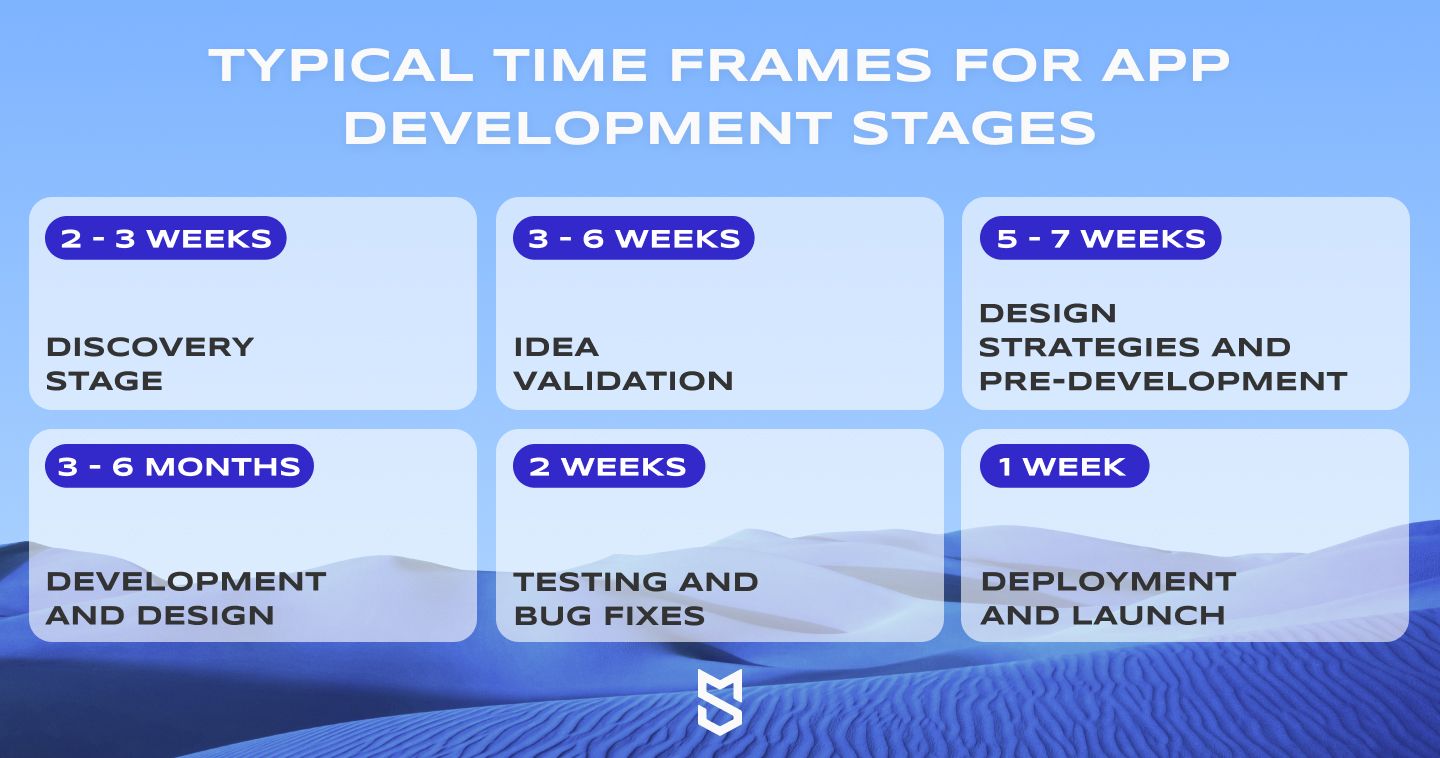
Discovery stage [2–3 weeks]
To build a good app, you should power it with an idea and a reason it should be used by the customers. Solving a problem, covering a market demand, or meeting the industry's unmet needs are the most common reasons for building an app.
The first thing to understand about successful apps is that they're successful because they solve a specific problem. People want solutions, and our task is to find the best implementation of your idea to cover the needs or to be the solution people seek.
Usually, our customers contact us with an idea in mind, and throughout the discovery stage, we:
- learn as much information as possible about it;
- define a target audience and the app’s goal;
- sketch the idea and create a vision to build project estimates based on it;
- define the risks and pitfalls, along with discussing the ways to avoid or deal with them;
- create a navigation concept to ensure that our team is on the same page with our client regarding the product vision;
- create a business plan, defining marketing strategies to find the best ways for an app to bring profit;
- write an app requirements document to establish clear expectations and criteria to determine the project’s success in the future.
Typically, out of the estimated time to build an app, we allocate 2–3 weeks to the research phase.In many aspects, the quality of the conducted discovery stage will significantly impact the eventual quality of the product. So, it’s better not to be stingy with time at this stage, and it’s definitely not recommended to skip it.
Idea validation [3–6 weeks]
After researching your idea, understanding the problem it will solve and establishing its solution, it’s time to proof-test your product’s vision at the idea validation stage. At this stage, there are many techniques that you can use to understand whether your product is needed and anticipated.
For example, during idea validation, you can:
- research your competitors and build a bigger picture of the market demand and how it is covered now;
- as after the previous stage you have the image of your target audience, survey your app’s potential users and receive direct feedback on whether anyone is going to pay for your solution or even be interested in it;
- validate a navigation concept by creating a test group of users to learn about their experience and what the app concept is lacking;
- build a medium-fidelity prototype and MLP to let the testing group outline the best features you need to focus on in development and point out the unnecessary ones with no practical use.
With the MLP and prototype creation, the idea validation stage may take from 3 to 6 weeks of the overall time to develop an app. Although it takes more time than the discovery phase, its significance is also much higher as it allows you to move from theories to practical applications of your idea.
Design strategies and pre-development [5–7 weeks]
After validating your idea, you now have an understanding of your future product’s core features and some design vision for the app’s aesthetics. It's time to implement them in a prototype. UI/UX design and pre-development stage is about gathering the information you learned in the previous stages and finding a way to make your app look unique and functional.
To do so, this phase is dedicated to creating a high-fidelity prototype of your app. Compared to the prototypes you’ve had earlier, this one also aims to gain feedback from your test group, but, in addition, it enables you to monitor your user behavior. This time, the prototype should have detailed UX and UI designs and core features, which take around 5–7 weeks of the estimated time to build an app.
Development and design [3–6 months]
The most unpredictable stage of app development in terms of time estimates is the coding and designing part. It is always unique and depends on the desired functionality, the number and the complexity of the features and design decisions. If your app has one core feature and you envision a minimalistic design, it won’t take 6 months to code and design your solution.
In general, it usually takes 3–6 months to design and develop an app, but you can always speed up the process by hiring more specialists and distributing the tasks between them more effectively.
Testing and bug fixes [1–2 weeks]
Some developers prefer conducting the first and only testing separately and right after the development ends. This approach makes companies vulnerable to situations when there is a bug in a component on which other components or even the whole structure rely. Therefore, fixing it this late significantly delays the development and increases the time it takes to make an app.
To avoid such situations, testing and bug fixes should be an irreplaceable part of every stage that requires any kind of feature development or design. In this scenario, the final separate testing phase is done to ensure the highest quality of the product. It usually takes up to 2 weeks to ascertain that most bugs are found, dealt with, and prevented in the future.
Deployment and launch [1 week]
After you’ve researched, prototyped, tested, designed, developed, and tested again, it’s time for the last step — the launch. In the first two stages, you have decided on the platform your app is designed for, which has also determined your future launching process.
Your app should be optimized to the requirements of the app store of your choice. The App Store has stricter regulations for apps to be distributed, while Google Play seems more allowing and less controlling in their requirements.
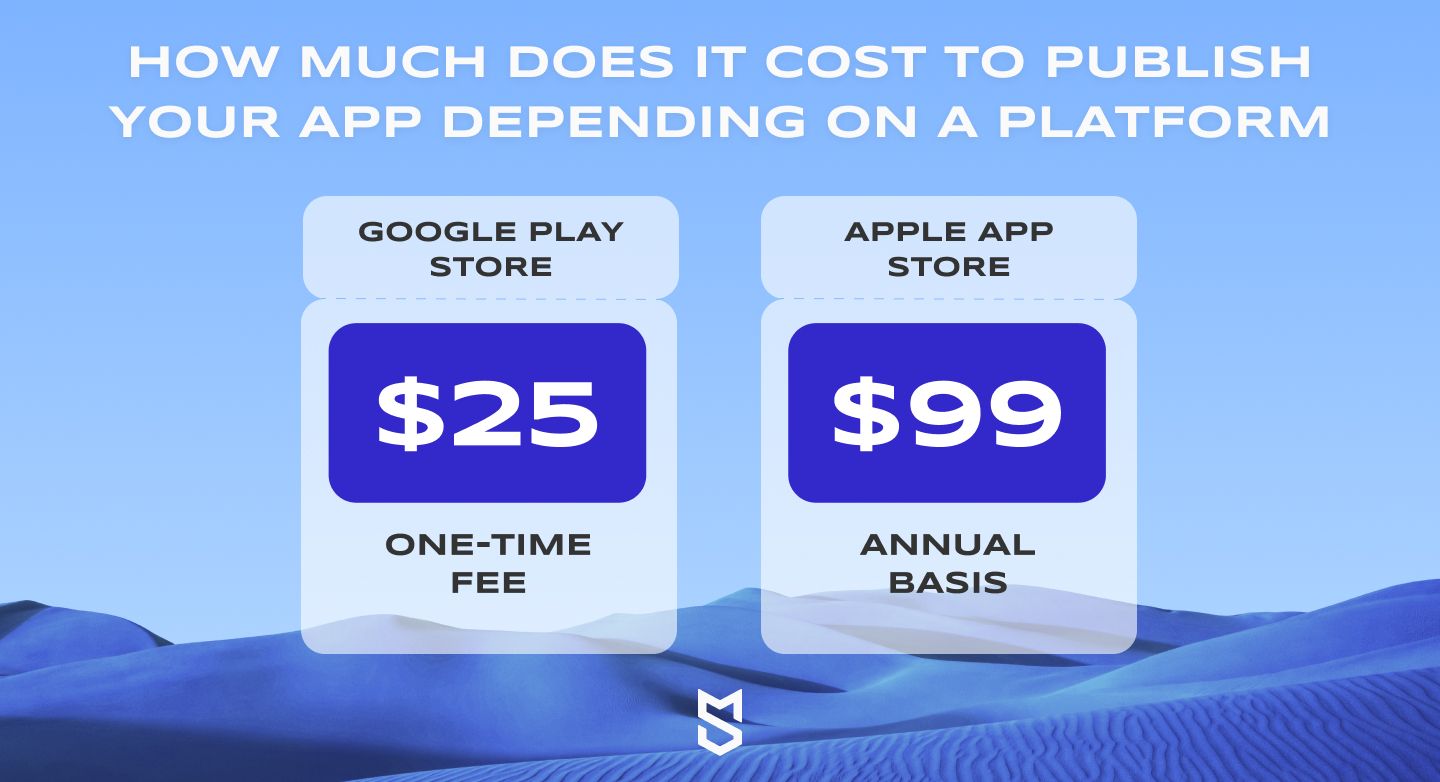
Besides the difference in regulations, there is also a cost difference for publishing your app:
- Launching your app on the Google Play Store costs $25 as a one-time fee when you register a developer account.
- Launching your app on the Apple App Store costs $99 annually.
Those are not all the nuances you face during the launch stage, and generally, it takes about one week to launch your app. However, there can be factors you can’t influence, such as the average time to get the approval from the app store, which can be around 1–2 weeks. After you are out of the app store’s submit-review-optimize circle, your app is successfully launched and ready for use until the next update.
Factors affecting app development timelines
While app development is a highly complex process, there are also some factors that you can control to build your solution faster than the typical time to make an app. So, in this section, let’s have a quick overview of what can help you shorten the time to develop an app.
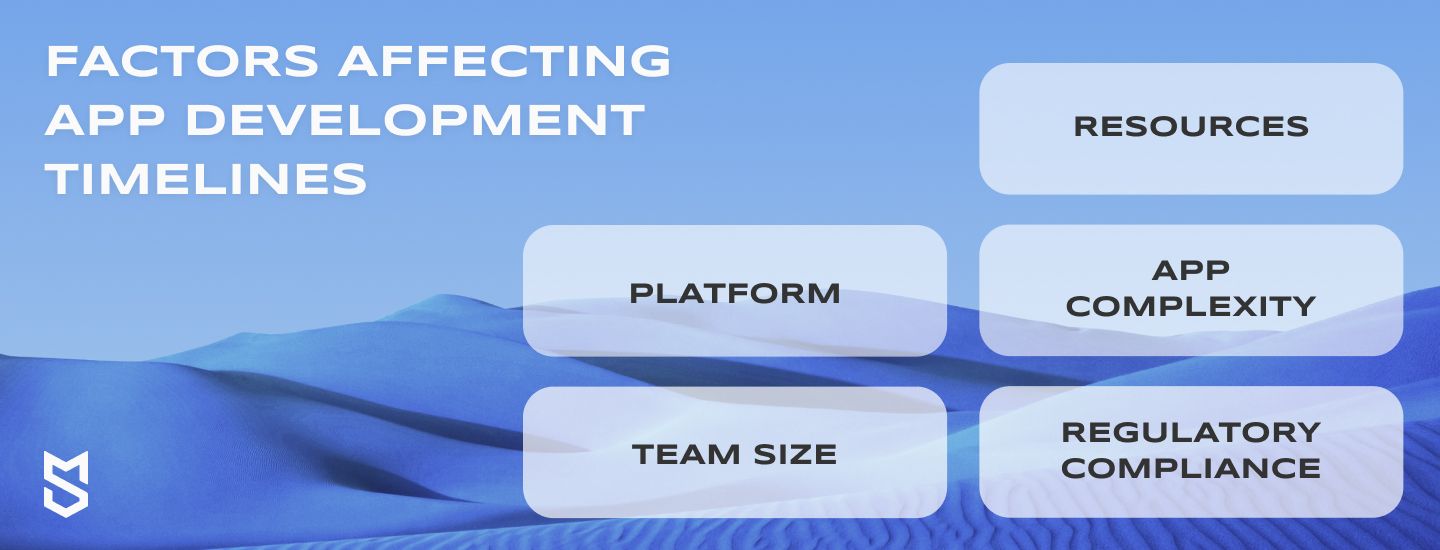
App complexity. If you want a set of core features and a complex design with a wide range of functions, don’t expect your team to meet the minimum time to build an app. But if you prioritize development speed and a quick app launch, stick to simplicity. Make your design decisions minimalistic and present your core features simply but efficiently. This way, you will lower the time to make an app and deliver the product even faster. In case you do need complex functionality, you can lower the development time by integrating third-party APIs instead of building it from scratch. But don’t forget to conduct thorough research before implementing, as not every solution will be safe and fit your business needs.
Platform. As we mentioned earlier, you decide on the desired platform at the earlier stages of development, and from there, you have several scenarios:
| You want to build an app for one platform without even considering the other option | In this case, your chosen platform won’t significantly affect your estimated time to build an app. |
| You want to build an app for one platform, look at how it goes and then consider developing an app’s version for another platform | In a scenario when your app does pretty well on one platform, your eventual development time will be twice as long as it was initially. All because now you need to separately consider both the average time to develop an Android app and the average time to develop an iPhone app in your estimates. |
| You want to launch your app on every platform at the same time | Developing two apps simultaneously will not postpone the launch date significantly since it takes approximately the same time to code for Android and for iOS. An alternative is to choose cross-platform development but keep in mind that the performance of cross-platform apps is lower than that of native apps, and some features will be impossible to implement. |
Team size and resources. By default, all time and cost calculations are made for one specialist per specialization (1 developer for each platform, 1 backend developer, and 1 UI/UX designer). However, if you want to speed up the development, you can hire extra people and distribute tasks/features to develop between them. Also, as a client, you can increase the development speed by establishing clear communication, updating your requirements in a timely manner and being easily accessible.
Regulatory compliance. If your solution is intended for industries with strict regulations, keep in mind that it will increase the average time to develop an app. For example, creating a HIPAA-compliant healthcare app will take longer, as it adds some stages to the development process we overviewed earlier. With regulations such as HIPAA, GDPR, CCPA, etc., it can take an extra week or even an extra month to deliver the product.
A real-life case study from Mind Studios
Would you believe it if we said we managed to build 4 mobile apps in 3 months for our client? We know it sounds unreal; however, this is the actual case from Mind Studios' history that we are willing to share with you. So, let’s go back to 2019, right before the pandemic, and look at the James Butler development.
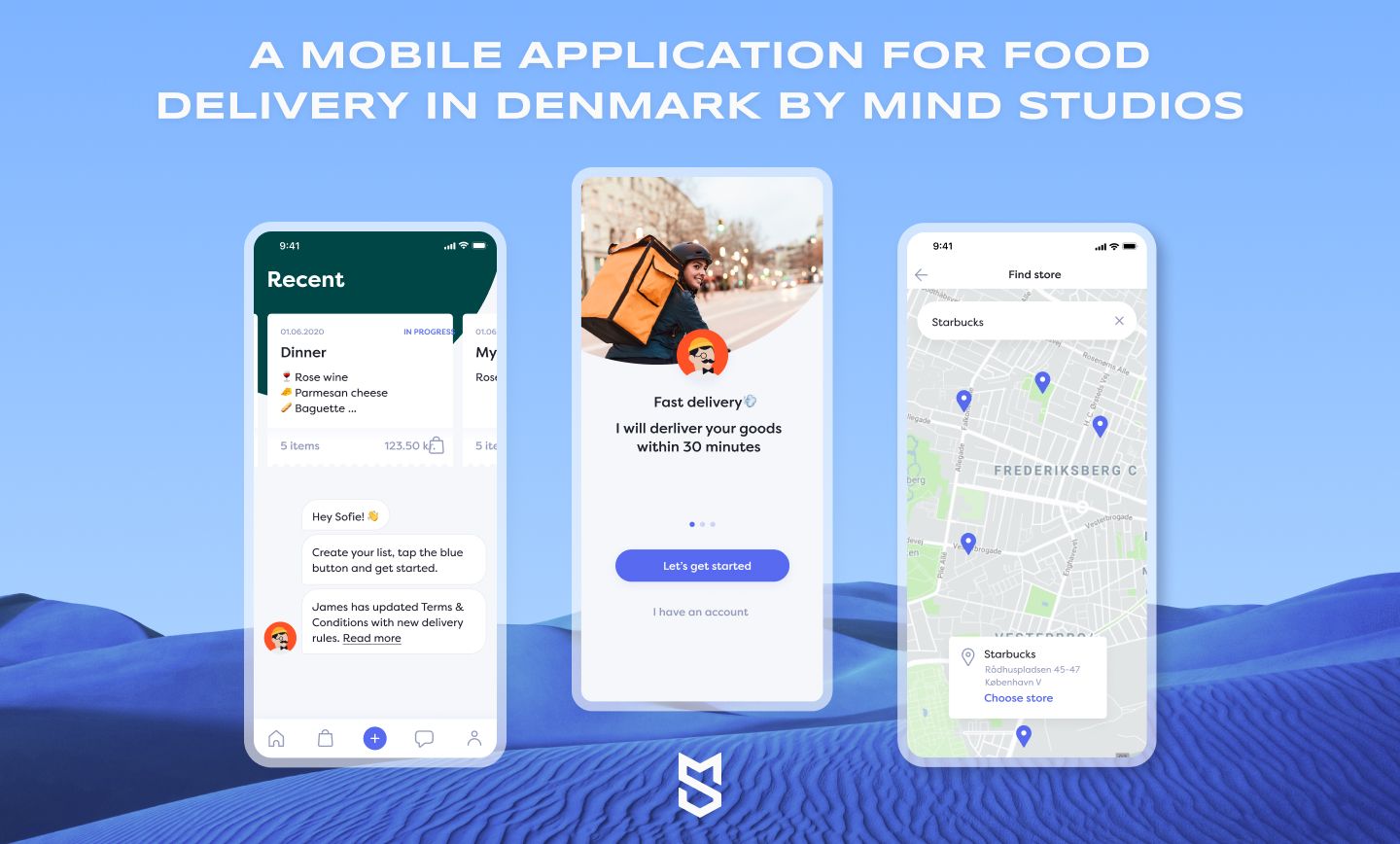
James Butler is a mobile application for food delivery in Denmark that made it possible for users to order anything from brick-and-mortar stores and have it delivered to their doorsteps within 30 minutes.
It was June 2019 when our client came to us with an idea. The idea was to build a food delivery app for the busy Danish people, where they could write a list of groceries they need without specifying the manufacturer or the shop and get it delivered quickly.
The main challenge we faced at the stage of negotiations was definitely the time limits that our client set. They needed the app to be ready by October 2019 so that they could attract solid investments that month with a ready-to-use application. So, we had only 3 months to build 4 food delivery apps, and we started the development.
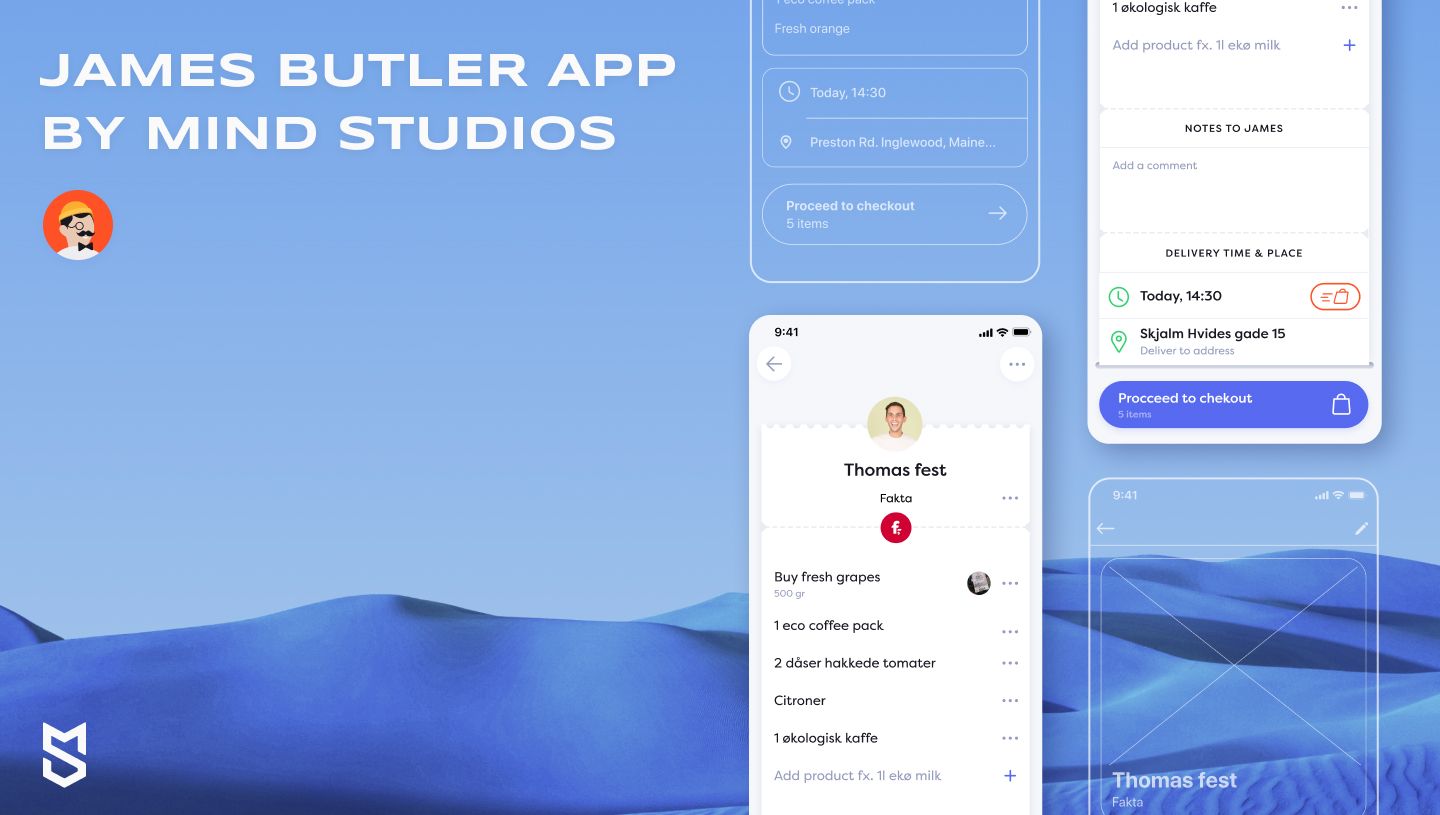
Why so many apps, you may ask? Delivery apps usually require two versions – a customer’s one and one for the delivery people. And our client initially needed both iOS and Android apps, which gets us 4 different apps.
Regardless of the incredibly short time boundaries, we managed to deliver 4 apps in 3 months and successfully launched them. Thanks to the clear and thorough communication and the engagement of every stakeholder, we overcame all the challenges we faced and fully met the users’ expectations. You can read the whole story from behind the scenes of the James Butler's development in our case study.
Conclusion
The average time it takes to develop an app is hardly predictable in terms of hypothetical estimates without a specific case. Usually, the process of app development consists of:
- Discovery stage [2–3 weeks]
- Idea validation [3–6 weeks]
- Design strategies and pre-development [5–7 weeks]
- Development and design [3–6 months]
- Testing [1–2 weeks]
- Launch [1 week]
In some cases, you can speed up the process by considering a cross-platform development strategy instead of building two apps separately. However, you are going to face functionality limitations in exchange for a couple of saved development weeks.
If you are struggling with estimating the time it will take to make an app or need some guiding light from the team of experts, Mind Studios is always here for you. Fill out our form, and our specialists will come back to you to offer a free consultation regarding the matter.

